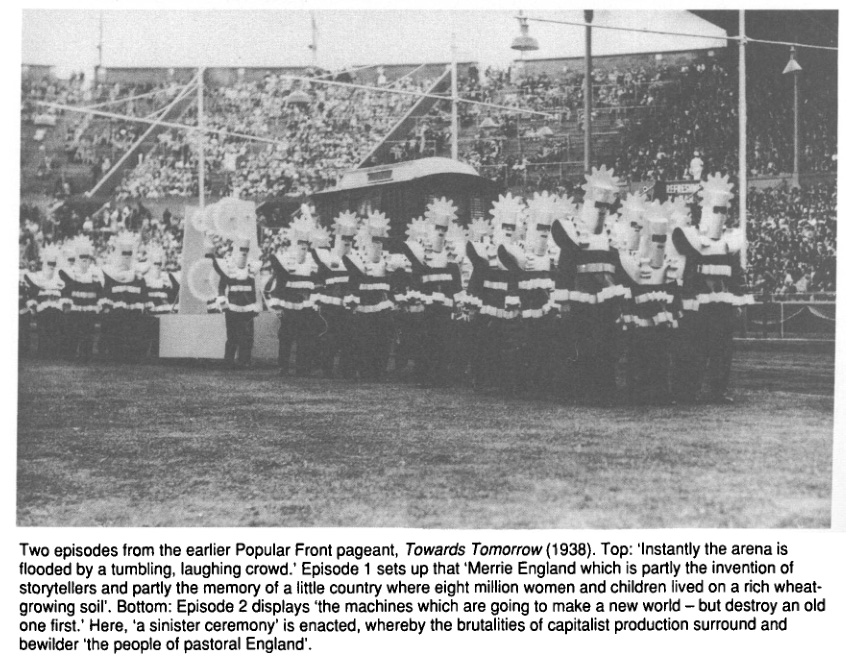
The lovely Peter Beader (AKA Pete The Temp) has been doing a tonne of research recently for his new book ‘Stage Invasion: Poetry & The Spoken Word Renaissance‘ and his new show ‘Homer to Hip Hop: a History of Spoken Word‘.
He came across an essay about a political pageant from the 1930s which has an interesting overlap with the structure of our show. The published essay is behind an academic paywall here but the author Mick Wallis has kindly provided his private copy of the essay which you can download from here if you don’t have an academic login to download from the link above.
Taken from the essay, here is the structure of a pageant performed to thousands of people in a stadium in the late 1930s:
Music and the People
Introduction
1. Feudal England. A canon from 1350; songs ‘that have lived in the peasant tradition for centuries, only lately collected because they were beginning to be forgotten’; a primitive fertility ritual dance; a Hebridean spinning song. (No dramatic action.)
2. The Massacre of the Innocents. Parts of two pageant-plays are performed, as if to the villagers: after the famous complaint from the Second Shepherds’ Play, Herod and the Innocents – ‘no doubt much of its popularity owed much to the memory of the massacres of their own people after the rising of 1381’; the song King Herod and the Cock in which ‘the invincible spirit’ wins against the oppressor; a choir of early Christians, following an introductory verse by Paul Robeson; and, since ‘the play’s not finished yet’
(i.e., of history) the Basque Lullaby.
3. Peasants in Revolt. A return to 1381: John Ball addresses the crowd; a signal arrives from him; the march on London, singing The Cutty Wren; Tyler’s meeting with Richard II, and murder (‘All words spoken in this scene, except for the commentary of the Speaker, are taken from authentic records’); all the men of the Mass Chorus (nine choirs) sing The German Peasants’ Song.
Interlude. ‘The ancient ritual carried on / And the forbidden message spoke’: members of the Woodcraft Folk ‘come on in small numbers, like conspirators, and perform the Stag-Dance’, part of the cult which was ‘the bond of unity between the harassed peasants’.
4. Soldiers of Freedom. Two Announcers briefly set the scene for 1649 (the episode is not concerned with celebrating Cromwell). ‘One king may be dead, but who still owns the land? Six Levellers and the actor-singer Parry Jones sit at tavern tables and sing; an Announcer recounts their talk as they remain in tableau; a group of dancers; some Diggers brought on in ropes by soldiers; an Announcer hails them in verse while the soldiers
order drinks; the Diggers sing Stand up Now.
5. Village Green to Concert Hall. Announcer’s verse reports the break-up of rural communities and the appropriation of their culture by bourgeois institutions; ‘A group of dancers enters and performs to the tunes from which The Beggar’s Opera was concocted. At the end of their dance, a proscenium arch appears over the platform, and a scene from the play is performed to the dancers as audience.
Interval
6. Changing Europe. 1792. French revolution, singing the Carmagnole, verses 1 and 2, dressed as French peasants of 1790
7. Prisoners. ‘Ludwig van Beethoven descends from rostrum’; ‘But who are these / In modern clothes appearing / Their haggard eyes / The brand of torture like a web of scorpions wearing?’; prisoners from the Nazi concentration camps enter and sing the Peat-Bog Soldiers’ Song.
8. Slaves. ‘Following this train of thought’, John Payne and his Negro Choir enter as slaves, singing a chain-gang song, a cotton-picking song, and some ‘songs of freedom, led by one of the foremost champions of freedom’, Paul Robeson’.
9. The People Advance. As Robeson’s Kneelin’ Low ends, the Mass Chorus sings the Chartist We’re Low and the Speaker takes up a prose narrative to take us forward to trade unionism – ‘To every trade its club, to every club its song’ – and ‘the Trades Unionists sit round a table and sing their song’ (unspecified), ‘the verse sung solo’; ‘the tide rose apace’, and in a few sentences taking in the Co-operative Movement, the Speaker takes us to the late 1880s – a crowd headed by William Morris enters, singing People of England; the Speaker relates the killing by the police of the demonstrator in Trafalgar Square in 1880, and William Morris gives his famous ‘Not one, not one, nor thousands must they slay’; the Chorus marches off to the Russian 1905 Funeral March, ‘that now commemorates all those who have fallen in the fight for freedom’.
The Speaker makes a summation in verse of the Pageant, and reflects on its meanings for us now:
And having present struggles and despairs
Sharp in our minds, remember too
The past whose urgent influence prepares
The issues of today, and know that you
By today’s action map the future’s road….
Never so needed was that single will
That unity of the people, to fulfil
The claim for freedom, and to ensure our peace…
It is time we answered, as they answer now
In Spain, in China, in every tortured land….
Let our song rise whose simple power
Can flood the boundaries that divide us still
And make our common hope, our single will.
Then a procession of groups: Christian Hymn; Levellers’ Song; Marseillaise; People of England; ‘Bandera Rossa’ ; German Solidarity Song; Chinese Student Song; Spanish National Anthem; (and now not representations but actual) veterans of the International Brigade led by Fred Copeman; the Negro Choir. Paul Robeson sings The Land of Freedom, ‘the great song of liberated Soviet humanity’, with the Acting Chorus (twelve choirs); Tom Mann, the Dean of Canterbury, and Fred Copeman speak briefly on the theme ‘Music and the People’ . Finally, all (audience included) sing the American Men Awake! the Day is Dawnin
